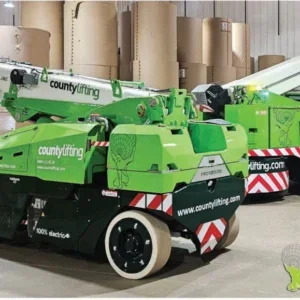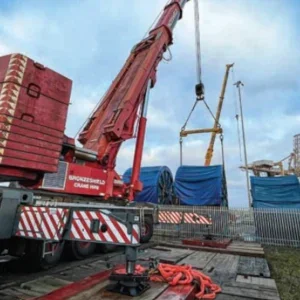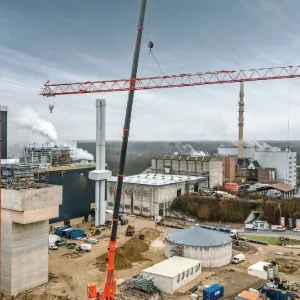Industrial machinery movers often cannot use standard lifting and moving equipment. Riggers need lifting muscle – machine presses can weigh more than 30t (33 US tons), and often exceed the rated load of forklifts. A building’s structure can restrict the use of a standard mobile crane and tight corners can limit the utility of a hydraulic extending gantry, even if it runs on rails.
For lifts of 30t or more in small spaces, there are three options: powerful cranes and forklifts intended for lifting heavy materials or equipment in a storage yard, compact factory forklifts (often called cushion tire lift trucks) or special cranes purpose-built for moving machinery. Yard forklifts resemble telehandlers and ride on large wheels with pneumatic tyres that reduce ground bearing pressure. Some have four wheels on the axle near the load. Some yard and factory forklifts can be specified with rigging attachments such as a cantilevered boom, generally known as a riggers boom that can be extended manually when unloaded, and that can lift (vertically) under load.
Two yard forklifts – Hyster’s H1050e/H48e and Linde’s H520, can be fitted with an attachment that handles shipping containers. Yard lifters, built for power, are also getting bigger. Rigger Lift’s R160 prototype, which rolled off the production line last month, can lift 72t (160,000 lb), making it one of the strongest of heavy forklifts. It expects to start selling the new model in June. Custom Mobile Equipment, the manufacturer of the Versa-Lift range, also has a launch planned for June – the 52t (115,000 lb) capacity heavy forklift model 85-115.
Italian crane manufacturer Valla this month launches a 90t (200,000 lb) yard crane, but further details were unavailable at time of going to press.
Rigging cranes are compact, powerful lifters with a set of wheels that swivel, like a forklift, so they can move around obstacles with a turning radius of about 6m. They use these wheels, rather than slewing rings, to manoeuvre the load. Most of the cranes come equipped with hydrostatic transmissions that transfer power from the engine to the drive wheels via fluid instead of mechanical connections. This system offers smoother inching control under load than a mechanical transmission. Almost all of the cranes, and now many of the forklifts, use a similar hydrostatic system for steering.
Forklifts and cranes can run on different fuels, ranging from gasoline and diesel to cleaner-burning liquid petroleum gas (LPG), compressed air (HP gas) or battery power.
Most of the cranes pick and carry loads with a telescopic main boom, although most can also be fitted with fork arms and carriers. Some of the fork arms tilt and some of the carriers can be moved from side to side. Some can also come with manually-extended booms that increase the machine’s reach.
Both forklifts and cranes balance their load with counterweight mounted on the rear. Customers may need to purchase extra counterweight to bring the crane up to full rated lifting capacity. Many of the rigging cranes, and a few of the forklifts, go a step further. The counterweight mounts on a rear chassis that, pushed by hydraulic rams, can extend off the back end a metre or more. This movement extends the wheelbase so that the machine becomes more stable. This means it can lift more – a third more, in some cases. Often, this is reflected in the model name. The forthcoming Versa-Lift 85-115, for example, is designed to lift 85,000 lb with retracted counterweight and 115,000 lb (52t) when the counterweight is extended away from the car body.
As tempting as it might be to assume a single operator can drive off the trailer and on to the site, in fact these heavy machines may require more set-up than a lighter forklift. Phil Matz, general manager of the machinery division at Days Corporation, says he sends out teams of one to six people with the Riggers Trilifter, depending on the complexity of the job.
Crane variants
Lift Systems offers three series of heavy lifters: Mobilift, Twinlift and Nimblelift. The Mobilift series, in two models, lifts loads with a single boom. It comes in 68t (75 US ton) and 41t (45 US ton) models, and specialises in high lifting. The 68t Twinlift series uses two booms in parallel. Though it lacks the vertical reach of the Mobilift, lifting eyes at the end of either boom make it better able to control payloads. Forks are options on both types of machine. A lighter-duty Nimblelift 45/60 – capacity up to 27t (60,000 lb) – comes with forks, but can be specified with boom or riggers boom. All three machines push out counterweight over the rear axle with a hydraulic ram.
Italian crane manufacturer Ormig’s range of yard cranes extends to a 45t model. Besides machinery moving, its cranes are used for moving metals and other materials in stockyards. Its boom can be extended under load. It can be fitted with forks, hydraulic and manual fly jibs and fixed hooks. A lighter-duty model, the 33TMBP, runs off electricity from a battery for clean-running operation inside factories.
The Riggers TriLifter lifts with a 3.7m (12ft) four-stage hydraulic extending gantry and also has a horizontally telescoping lifting frame. Unlike a hydraulic gantry, it circles, with a turning radius of about 6m (20ft). The TriLifter can either pick and carry loads slung from the sideframe or carry loads placed on top. A fork attachment is an option and the forks can spread to1.8m (6ft), but they cannot tilt or side-shift. It can extend the boom, but not the fork attachment, under load. Like many of the other lifters, its counterweight can be extended backward to increase its lifting capacity. But when the Trilifter is carrying a load on the gantry, it can move the counterweight in and out to make tight turns. When the rams push out the counterweight, reaction forces push the TriLifter forward without a jolt that could swing a load. Approximately 100 of these $220,000 to $300,000 machines have been sold around the world, since the first 45t (50 US ton) model was launched in 1985. In 1998 three new models came to market: the TL 100, which lifts a maximum of 45t (100,000 lb) on the boom and 68t (150,000lb) on top; the heavier-duty TL 150; and the variant TL 150BW, which has larger wheels to reduce bearing pressure by 25%.
Royal Tractor’s Rig-N-Lift heavy lifter, launched in 1997, comes in six weight classes, up to 45t capacity. The most popular model, the 40/60, lifts a maximum of 18t (40,000 lb) with counterweight retracted and 27t (60,000 lb) when it is extended by hydraulic rams. There are more than 30 such models working in the field, the company says. The 40/60 can be specified with a manually-extended riggers boom, boom or forklift. The newest Rig-N-Lift machine, launched in July 2002, lifts heavier loads with a two or three-stage extendible boom. These BT series models also take advantage of an extending rear frame. The BT 150 lifts a maximum of 68t (150,000 lb), the BT120 lifts 54t (120,000 lb) and the BT70 lifts 32t (70,000 lb). BT models can be specified with a winch, line and block or carriage and fork. The BT series can also telescope under load.
Like Ormig, Valla builds a heavy crane that can run off battery power (or diesel fuel). The 450D heavy crane, rated at 45t, rides on pneumatic tyres to the rear and cushion tyres in front.
Heavy forklifts
Custom Mobile Equipment’s Versa-Lift range can handle rigging or materials handling jobs with either a rigging boom, or a forklift, or both. Three models range from the 25/35, which lifts 16t (35,000 lb) with the counterweight pushed out, to the 27t (60,000 lb) capacity 40/60. On all three models, counterweight can be removed several tonnes at a time.
Elwell-Parker’s top-of-the range ESI 1000 heavy lifter (45t/100,000 lb) is also primarily designed for moving materials around a site, such as metal coils. Its fork face tilts 9°, though it cannot side shift. A riggers boom is an option. Seven smaller models are also offered.
Hyster’s heavy cargo handlers are generalists. ‘We expect them to cope with large awkward materials in not the most pleasant or comfortable conditions,’ says promotions officer Peter Madoc-Jones. The 48t capacity H48e/H1050e forklift-style lifter will transport steel to a press, or perhaps the press itself.
Linde has four different ranges of heavy forklifts. The strongest model is the H520, which is an engine powered counterbalanced truck with a lift capacity of 52t. Tilting forks with side-shifting carriage comes as standard.
Rigger Lift has designed two heavy forklifts. The Extreme Lift RC50-70, put into production last year, is designed for heavy lifting in spaces without much room to move. Even with an extending 7t counterweight and 2.5m-long forks the 32t (70,000 lb) capacity lifter still only measures 6.5m in length. The other machine, almost a third bigger, is the 54t (120,000 lb) Rigger Lift R120. Riggers booms are options on both.
In June 2002 Taylor Machine Works launched the TR-120 Rigger Truck, its first lifter designed for machinery movers. The TR-120 forklift can be specified to lift to heights of 3.2m and can lift 54t (120,000 lb) loads up to a height of 1.2m. Only two have been built.






